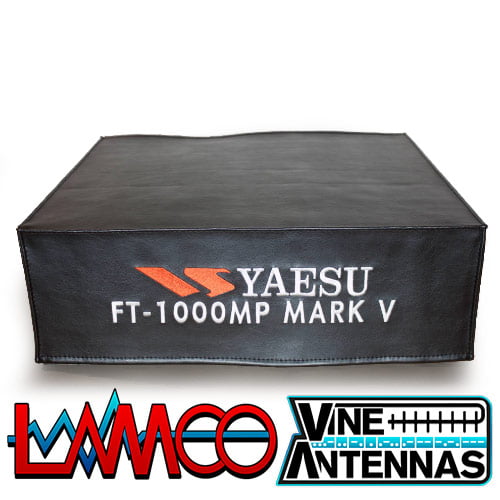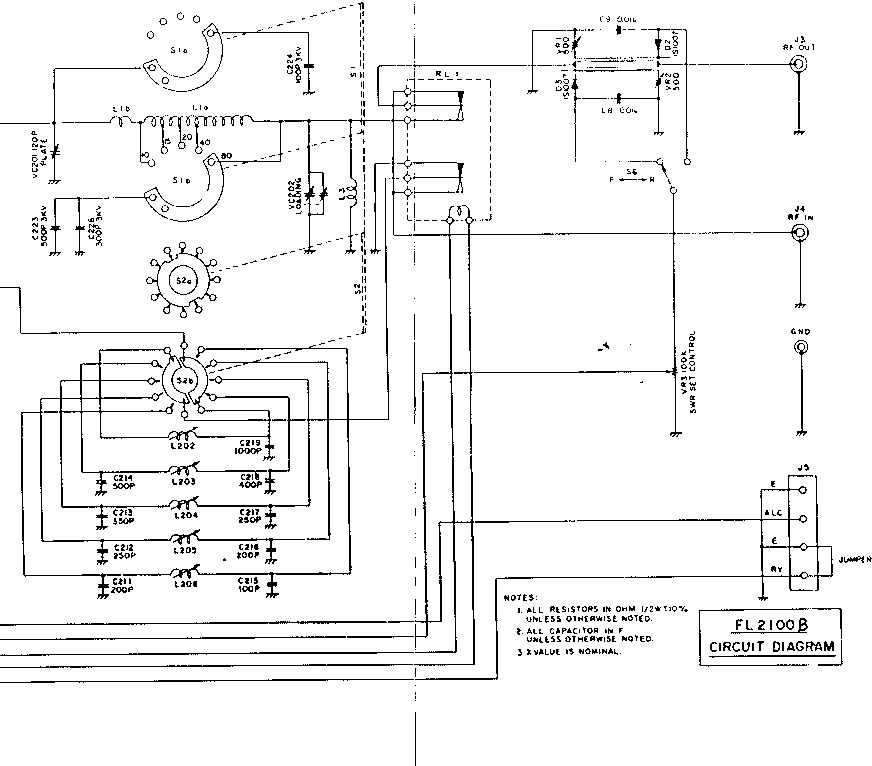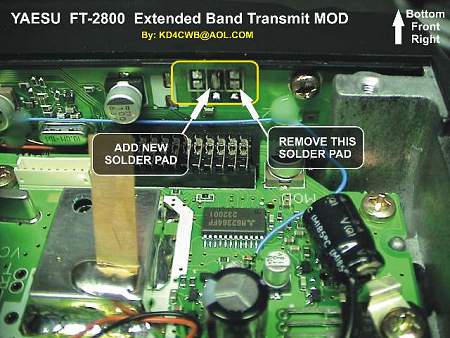The FT1000D comes equipped with additions including I.F. Filters for the 455khz. c.f. The narrowest of these has a 500hz. bandwidth, but no matching filter for the 250hz. bandwidth for the 455khz. I.F. This means that if you select the 250hz. bandwidth filter in the second I.F., it is paired with the 2.4khz. filter in the third I.F. It is a simple modification to have the control section select the 500hz. filter in the third I.F. instead.
The new Yaesu FT-1000D was designed sparing no effort or expense for optimum performance and operability. The FT-1000 is the fruit of over 25,000 man-hours of intensive research and development by Yaesu's top design engineers. Amateurtech@yaesu.com Contact us (714)827-7600 between 8AM – 5PM PST Parts Department option 4 Customer Service option 5 Technical Support option 8 No RMA or Preauthorization is required prior to sending in your radio: Please email Customer Service customerservice@yaesu.com to verify your product is still serviceable. To send in your radio. As with all of my modifications, you should have the FT1000 Service Manual. The following mod is accomplished with just two resistors. Here's the compete instructions: 1) Remove the TOP COVER (8 screws) and the POWER AMP shroud (6 screws) on the back of the radio. 2) Locate thermistor TH7602 where it solders into the PS UNIT Board.
This modification requires the addition of a switching diode (1N4148, 1N918 etc.) between the select line on the 250hz filter spot and the 500hz. filter.
First access the filters on the I.F. board, and clip the diode as indicated for the installation of the 250hz. filter in the manual. Then remove the 500hz. filter, note that the I.F. filter position for the 500hz. filter is the second from the front of the radio.
Then solder the diode between the cathode end of the 250hz. select diode, and the cathode end of the diode under the 500hz. filter. This diode should be oriented with the cathode toward the 250hz. select diode's cathode end.
Yaesu Ft-1000d Service Manual
Now when the 250hz. third I.F. control pulls the select line low, the new diode will pull the 500hz. filter select line low, selecting that filter in place of the 2.4khz. filter.
When you finish this modification you will note that the 500hz. filter reduces the wideband noise, and the 'Width' control works when the 250hz. filter is selected.
N4ATS - This website is devoted to the Yaesu FL-7000 Amplifier. Yaesu FT1000D Service manual: From: 'John L Merrill' Date: Sun, 9 Jan 2005 07:54:52 -0500: List-post: yaesu@contesting.com Looking for a service manual, paper version. Please reply direct.
Because of the mismatch in the filter bandwidths, the first few detents on the width control act as an I.F. shift, when the 500hz. filter is offset enough to 'catch up' with the bandwidth of the 250hz. filter, the action changes to a bandwidth control.
On my radio, the first three detents act as an I.F. Indesign 2020 portable. shift, and the next three reduce the bandwidth to under 100hz.
Important Addendum to KD5VC 250Hz Filter Mod
In KD5VC's mod, the references to connecting a new diode between the cathodes of the 250Hz and 500Hz select diodes means to connect to the PCB solder pads that the cut diodes' cathodes were formerly connected to, not to the cut flying leads on the actual diodes themselves! The 250Hz select diode is D2045 and the 500Hz select diode is D2046. Both are clearly marked on the PCB.
This mod also appeared in QST, Jun 96, p.70 (with the same ambiguous narrative). I have installed it and it works very well. An FT-1000D does not ship with the 250Hz 3rd IF filter- it is an option. This circuit trick can save you the cost of a crystal filter- with a 5 cent diode- while still greatly improving CW performance at 250Hz BW over the factory stock configuration. For FT-1000 owners: note that the mod assumes that the 250Hz 2nd IF filter is already installed. The purpose here is to cascade the 500Hz 3rd If filter with the 250Hz 2nd IF filter.


The problem is that there is only one switch on the front panel for these two independent choices. A little switch, S1001, on the RF board selects which function the front panel switch will control. The function for the other antenna choice is then completely lost.
Yaesu Ft-1000d Service Manual
Most operators choose the setting which allows the front panel switch to control the main receiver antenna. Then the subreceiver is permanently connected to the main receiver front-end; this leaves the BPF out of the circuit, and limits the frequency range of the subreceiver, as in the MP. In this common situation, the BPF has no function, and the subreceiver is unable to use a separate antenna.
2. Solution. Add another switch. This switch will work exactly as if it were the front panel RX ANT switch, and as if S1001 were set for the subreceiver.
The modification is electrically extremely simple and quite obvious; the only effort is in mounting the switch and connecting the wires. The new switch is added on the back of the BPF unit, between the attenuator switch and the subreceiver antenna jack. The modification requires no circuit board mods, no surface-mount work, and only a few parts.
Is it a good idea to drill holes in the radio? I never worry about resale value, and would never sell this fine radio.
Anyway, a knowledgeable buyer would appreciate the modification. The switch is quite inconspicuous. In any event, the holes are not in the radio proper, only in the hidden BPF chassis, and in the little black replaceable cover.
3. Operation.
- The front panel switch controls only the main receiver.
- The rear switch controls the subreceiver. No labels are needed on the switch. DOWN towards the antenna jack selects that jack, and what is usually the lower antenna, such as a Beverage. UP selects the main receiver antenna source, and what is usually the upper antenna, up on a tower.
- In most cases, the RX ANT and SUB RX ANT jacks can be tied together with adapters and short jumpers, and then connected to one auxiliary antenna. This will allow the auxiliary antenna to be used with either receiver, or both at once.
4. Materials.
- One miniature switch, SPST, 1/4 inch bushing. Single pole; double pole would be too wide. A sub-miniature switch, 3/16 inch bushing, might be even better.
- Two pieces hook-up wire; 24 inches and 2 inches. Not too heavy or thick. #24 stranded, 0.010 inch insulation. Alpha #1854 is okay. Best is Alpha #7054, irradiated, solderingiron resistant, Mouser #602-7054-100-01, www.mouser.com.
- Two small cable ties.
- Five small glass jars to hold the different types of screws.
5. Installation. This procedure is not specified in great detail here, but hams with experience working on the FT-1000D (this does not include me) will find the modification very easy. Radios from different production runs may have differences in layout; they might not correspond to the steps below, and require slight changes in the procedure.
5A. RF board.
Yaesu Ft 1000d For Sale
- Remove covers from radio.
- RF board is to be lifted sideways.
- Remove three coax cables near outer rear corner; sketch positions, cut off cable tie.
- Cut off cable tie from large wire bundle at outer front.
- Remove cardboard shield.
- Switch S1001 to R ANT.
- Remove three screws from rear, which hold connectors. Note that one screw is machine, two are taping; these should not be interchanged.
- Remove board screws and lift board sideways.
- Strip and tin one end of long wire only 1 mm; tack onto outer terminal of S1001; this is the E BPF terminal.
- Run wire up to board top through the unused corner hole.
- Replace board; shield, 6 board screws, 3 rear screws.
- Replace cables.
- Replace two cable ties.
- Feed wire up along corner, and over above BPF.
5B. BPF.
- Remove BPF unit.
- Remove black mounting plate.
- Remove shield.
- Remove BPF board from BPF chassis. Lead unsolders from coax connector, which stays on chassis.
- Drill hole for switch in BPF chassis lip between attenuator switch and coax connector.
- Removing the BPF circuit board ensures that all drilling fragments can be removed from the chassis - one fragment can kill a radio.
- Drill matching hole in black cover plate.
- Attach switch to chassis; body close to lip, no spacer nut inside chassis. Orient switch according to convention noted above.
- Install BPF board. Attach black plate.
- Connect one side of the switch to +13. There is a convenient fairly large +13 pad on the relay sub-board; it is easy to locate because there are only four leads to the sub-board: two antenna leads, a ground lead, and the +13 lead. Early versions of the BPF might not have a subboard.
5C. Final installation.
- The wire is fairly long for two reasons. One is installation convenience. The other is to allow slack in case the RF board is to be lifted in the same manner at a later date.
- Position the BPF unit on the workbench behind the BPF opening.
- Run wire up in corner, over and above BPF area, out through opening, and into the BPF chassis through the cutout for the two connectors.
- Attach wire to switch. ON should be with the switch toggle towards the coax connector.
- Attach BPF shield.
- Install BPF unit.
- Look for left-over hardware and things that I forgot to mention.

The problem is that there is only one switch on the front panel for these two independent choices. A little switch, S1001, on the RF board selects which function the front panel switch will control. The function for the other antenna choice is then completely lost.
Yaesu Ft-1000d Service Manual
Most operators choose the setting which allows the front panel switch to control the main receiver antenna. Then the subreceiver is permanently connected to the main receiver front-end; this leaves the BPF out of the circuit, and limits the frequency range of the subreceiver, as in the MP. In this common situation, the BPF has no function, and the subreceiver is unable to use a separate antenna.
2. Solution. Add another switch. This switch will work exactly as if it were the front panel RX ANT switch, and as if S1001 were set for the subreceiver.
The modification is electrically extremely simple and quite obvious; the only effort is in mounting the switch and connecting the wires. The new switch is added on the back of the BPF unit, between the attenuator switch and the subreceiver antenna jack. The modification requires no circuit board mods, no surface-mount work, and only a few parts.
Is it a good idea to drill holes in the radio? I never worry about resale value, and would never sell this fine radio.
Anyway, a knowledgeable buyer would appreciate the modification. The switch is quite inconspicuous. In any event, the holes are not in the radio proper, only in the hidden BPF chassis, and in the little black replaceable cover.
3. Operation.
- The front panel switch controls only the main receiver.
- The rear switch controls the subreceiver. No labels are needed on the switch. DOWN towards the antenna jack selects that jack, and what is usually the lower antenna, such as a Beverage. UP selects the main receiver antenna source, and what is usually the upper antenna, up on a tower.
- In most cases, the RX ANT and SUB RX ANT jacks can be tied together with adapters and short jumpers, and then connected to one auxiliary antenna. This will allow the auxiliary antenna to be used with either receiver, or both at once.
4. Materials.
- One miniature switch, SPST, 1/4 inch bushing. Single pole; double pole would be too wide. A sub-miniature switch, 3/16 inch bushing, might be even better.
- Two pieces hook-up wire; 24 inches and 2 inches. Not too heavy or thick. #24 stranded, 0.010 inch insulation. Alpha #1854 is okay. Best is Alpha #7054, irradiated, solderingiron resistant, Mouser #602-7054-100-01, www.mouser.com.
- Two small cable ties.
- Five small glass jars to hold the different types of screws.
5. Installation. This procedure is not specified in great detail here, but hams with experience working on the FT-1000D (this does not include me) will find the modification very easy. Radios from different production runs may have differences in layout; they might not correspond to the steps below, and require slight changes in the procedure.
5A. RF board.
Yaesu Ft 1000d For Sale
- Remove covers from radio.
- RF board is to be lifted sideways.
- Remove three coax cables near outer rear corner; sketch positions, cut off cable tie.
- Cut off cable tie from large wire bundle at outer front.
- Remove cardboard shield.
- Switch S1001 to R ANT.
- Remove three screws from rear, which hold connectors. Note that one screw is machine, two are taping; these should not be interchanged.
- Remove board screws and lift board sideways.
- Strip and tin one end of long wire only 1 mm; tack onto outer terminal of S1001; this is the E BPF terminal.
- Run wire up to board top through the unused corner hole.
- Replace board; shield, 6 board screws, 3 rear screws.
- Replace cables.
- Replace two cable ties.
- Feed wire up along corner, and over above BPF.
5B. BPF.
- Remove BPF unit.
- Remove black mounting plate.
- Remove shield.
- Remove BPF board from BPF chassis. Lead unsolders from coax connector, which stays on chassis.
- Drill hole for switch in BPF chassis lip between attenuator switch and coax connector.
- Removing the BPF circuit board ensures that all drilling fragments can be removed from the chassis - one fragment can kill a radio.
- Drill matching hole in black cover plate.
- Attach switch to chassis; body close to lip, no spacer nut inside chassis. Orient switch according to convention noted above.
- Install BPF board. Attach black plate.
- Connect one side of the switch to +13. There is a convenient fairly large +13 pad on the relay sub-board; it is easy to locate because there are only four leads to the sub-board: two antenna leads, a ground lead, and the +13 lead. Early versions of the BPF might not have a subboard.
5C. Final installation.
- The wire is fairly long for two reasons. One is installation convenience. The other is to allow slack in case the RF board is to be lifted in the same manner at a later date.
- Position the BPF unit on the workbench behind the BPF opening.
- Run wire up in corner, over and above BPF area, out through opening, and into the BPF chassis through the cutout for the two connectors.
- Attach wire to switch. ON should be with the switch toggle towards the coax connector.
- Attach BPF shield.
- Install BPF unit.
- Look for left-over hardware and things that I forgot to mention.
6. Note. The setting of switch S1001 on the RF board should not be changed to E BPF after this modification is installed. There is no reason to do so. However, if the switch is set to E BPF, and the new subreceiver antenna switch is set for the subreceiver antenna jack, and the front panel RX ANT button is pressed, then Q1026 will receive 13 volts from two different sources, connecting these sources together. These are probably ultimately the same source (I didn't bother to check), so it would be okay, but it's not a good idea. (The schematic on page 29 of the operating manual is only a simplified version, and is totally misleading.) Removing S1001 would eliminate any hazard (and eliminate the most unfortunate component in the radio). A drop of epoxy cement, or red nail polish, on the switch to freeze it would be the easiest solution.

